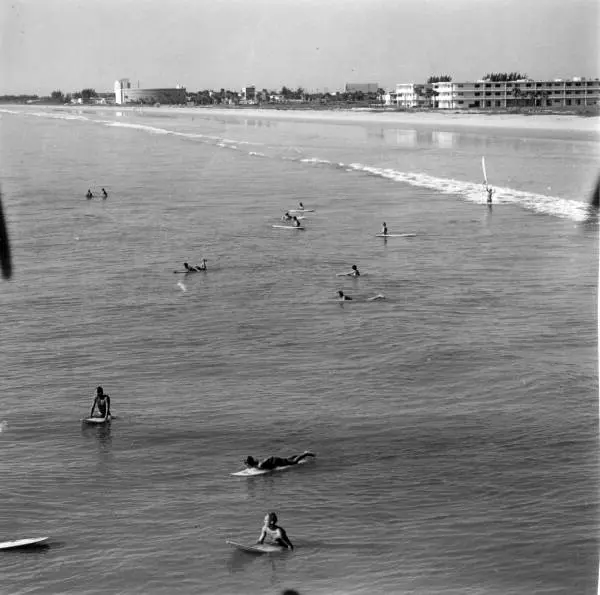Surfing has been ingrained into American popular culture since the 1960s. Even people who have never touched a surfboard have been influenced by the music, movies, and philosophy of the surfing community.
Since the mid-twentieth century, Cocoa Beach has been a prominent home for surfing in Florida.
On Friday, April 21, the new temporary exhibition “Surfin’ FLA: Celebrating Surfing in Cocoa Beach and the Sunshine State” will open at the Brevard Museum of History and Natural Science, 2201 Michigan Ave., Cocoa. Tickets are $15 and include a wine and cheese reception from 6pm-8pm, with special guests and admission to the museum. Reservations are available at www.myfloridahistory.org.
“Surfing was in Hawaii for centuries, and then it slowly started to make its way over to California,” says Madeline Calise, manager of the Brevard Museum of History and Natural Science. “It started to show up in areas of Florida in the early 1900s, mostly as belly boarding, which is lying prone on a board. That’s when we started to get railroads down the coast, which is when Florida became a tourist destination.”
In the early 1900s, beaches became tourist attractions in Florida, with coastal communities building amenities such as hotels, bathing houses, boardwalks, piers and seaside casinos.
“Brothers Dudley and William Whitman first saw someone surfing on a Hawaiian board that they had brought in around 1930, and Bill Whitman actually built the first Hawaiian style board in Florida,” says Calise. “That was out of sugar pine wood, about 10 feet long, so in the beginning it was Hawaiian style boards. Around 1930, you started to see a bit of surfing in Daytona, a little bit on the Gulf Coast, a little bit in Miami, but then in World War II, surfing pretty much disappeared in Florida.”
In the 1940s, Florida became a military training ground. German submarines patrolled Florida’s coast, and recreational activities on the beach were curtailed. After the war ended, tourism in Florida was revitalized, and the population of the state grew exponentially, particularly in Brevard County.
“We had the space program, and Patrick Air Force Base, and you had large populations coming in with families, and of course those kids wanted to pick up the new cool sport, which was surfing,” says Calise. “In California, North Carolina, and other areas, surfing was also gaining pop culture traction. There were movies like ‘Gidget’ in 1959, and ‘Endless Summer’ in the ‘60s, which was the seminal surf movie. It was a cool sport, it was accessible, and almost anyone could do it, especially in Florida where the waves are a bit more modest, a bit more suited for beginners. We still have the hurricane months where the waves can get pretty big.”
As surfing became popular in the 1960s and ‘70s, it inspired a genre of music that included groups like the Ventures, the Surfaris, and the Beach Boys. The name of the Brevard Museum exhibit “Surfin’ FLA,” was inspired by the Beach Boys song “Surfin’ USA.”
As surfing became a part of popular culture, more people wanted to try it.
“In the 1970s, the short board revolution came in,” says Calise. “It was easier for women to carry around short boards than ten foot balsa wood boards, so more women got into it.”
Around the same time, a tradition of making surfboards developed in Florida.
“Most boards came from California, but people started to make their own boards,” says Calise. “They would strip down their boards; they would reshape the cores, and then put more coverings on it, so they eventually kind of redid the skin. That’s how the Florida surfboard makers industry really started.”
One of the featured guests at the Friday evening opening reception of the “Surfin’ FLA” exhibit will be George Robinson of Melbourne, Florida, who is recognized internationally for his hand crafted surfboards. For more than 30 years, Robinson has created a few dozen custom made balsa boards each year.
The exhibit consists of original informational panels and video, along with items on loan from the Florida Surf Museum. Also featured in the exhibit are 11-time World Surf League Champion Kelly Slater, and Ron Jon, the largest surfing shop in the world, both of Cocoa Beach.

